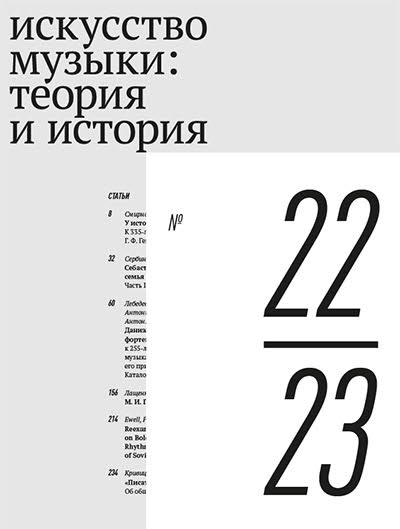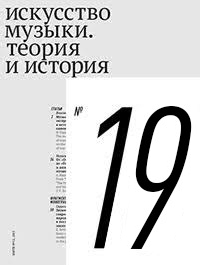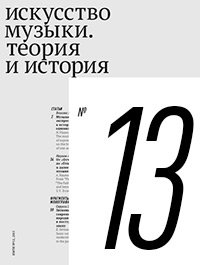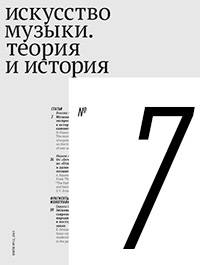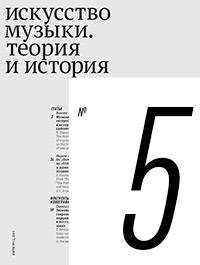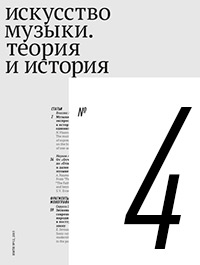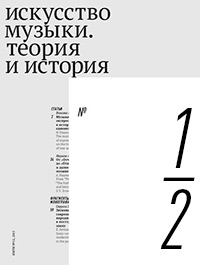2012 ¹ 4
The idea of this issue came under the influence of the Keldïsh Conference of 2011, dedicated to Russian-Spanish musical relations. Not all the papers delivered at the conference have been converted into scholarly articles. On the other hand, not all the topics discussed in the published articles were explored during the conference. Be that as it may, the main subject matter of both the Keldïsh Conference of 2011 and the present issue of our periodical is the interaction between Russian and Spanish musical cultures.
One of the conference’s major events was the presentation of S. Tïshko’s book ‘Glinka in Spain’, recently published in Kiev (an excerpt from it was published in No. 1–2 of our journal). The book is reviewed in this issue.
The materials published in this issue include also a list of dissertations in musicology defended in Russia during recent years (2008–12). It gives a general idea of the scope of topics covered by our field and of the problems that are especially attractive for the specialists.
The history of Spanish concert tours of two great Russian musicians is examined in the broad context of the development of Spanish musical culture and concert life, including both artists’ contacts with native musicians and great international stars. The text is supplemented with previously unpublished illustrative materials.
In Russian musicological literature, this is the first attempt to analyze the phenomenon of “Spain in Stravinsky’s reception”, taking into account such aspects as the reflection of Spanish subjects in Stravinsky music. Stravinsky’s response to Spanish music and Spanish artistic mentality, the circle of Stravinsky’s contacts among Spanish musicians and artists.
The article deals with various aspects of the theme ‘Prokofiev and Spain’: from Prokofiev’s childhood, his youthful studies of Spanish and his acquaintance with the music of contemporary Spanish composers through his meeting with Lina Llubera, the history of Spanish subject matters in his music, and his contacts with Spanish musicians.
The essay presents the history of the great dancer and choreographer Leonid Myasin’s (also known as Massine) acquaintance with Spain. His Spanish impressions were reflected in his ballets staged in collaboration with eminent Russian and Spanish artists. Myasin’s contribution to Spanish theme is characterized as the most outstanding body of ballets ever created on Spanish subject matters.
The study of the autograph score of the comic opera Fedul and his Children composed in 1791 by Martín y Soler (in co-autorship with V. Pashkevich, to libretto by Catherine II) has proved that a certain part in the work’s creation was played by Giuseppe Sarti. The manuscript contains numerous editorial corrections made by Sarti’s hand; the reasons for his participation in the project are discussed.
The article deals with the famous Spanish romantic composer R. Carnicer’s opera Il dissoluto punito, ossia Don Giovanni Tenorio. The author analyzes the structural features of the opera and its position in the history of Spanish musical theatre. A special objective is to examine the influence of Mozart and Rossini on Spanish music and musical life.
Analyzing M. Balakirev’s piece based on a theme proposed by M. Glinka (in two versions) and comparing the piece with Glinka’s own Spanish overtures, the author shows that by mid-1850s Glinka’s tradition was substantially transformed in the oeuvre of his immediate successors. The author also pays attention to the fact that in this early piece a new, uncompromisingly tragical idea of history was formed; this allows to compare Balakirev’s vision of history with the more recent musical “historiosophy” of Musorgsky.
The article presents the history of early productions of Carmen in Russia, preceding the opera’s translation into Russian and its triumph on the stage of the Russian Imperial Opera in 1885. Since then, Carmen has been largely perceived in Russia as a symbolic image of Spain. An information is provided about the performances, as well as about the performers of the title role: M. A. Slavina, E. K. Pavlovskaya, and M. Figner.
The article deals with the history of the reception of Bizet’s opera during the Soviet era. The examined topics include the specifics of the symbolization of its image in mass culture, the rise of new connotations conditioned by the ideological and artistic contexts of the Soviet epoch, the most important staging conceptions of the ‘20–30s, the adaptations of the opera’s different meanings by means of ‘word about music’. The comparative analysis of the main role’s stage interpretations shows how the verbal elucidations of the opera’s substance influenced the Carmen performance canon in Soviet theatres.
The review of the book Glinka’s Wanderings. Commentary to “The Memoirs”. Part III. Journey to the Pyrenees, or Spanish Arabesques by S. V. Tyshko and G. V. Kukol’ (Kiev, 2011) consists of three parts. The first part considers a novelty of the authors’ answer to the question: why did Glinka travel to Spain? The second part is devoted to methodological aspects of the study. The third part includes comments on the book from the leading Ukrainian scholars Nina Gerasimova-Persydska, Maryna Cherkashyna-Gubarenko and Elena Zinkevich.







